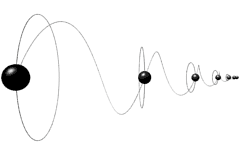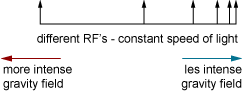
Universal principle of speed of light
Formula for speed
![]()
is a formula of space-time relation. Speed “v” equals to space “s” divided by time “t”. So from that formula we can express relations for space and time.
Space is equal to a product of speed and time:
![]()
Time equals to space divided by speed:
![]()
According to that, speed is a frame of space-time manifestation, space is a frame of time-speed manifestation and time is a frame of space-speed manifestation. It emerges that speed, space and time are indivisible aspects of one.
If the Universe exists on one principle, than all of its physics should be explainable through that principle. Since its existence is determined by its space-time frame, the manifestation of that frame is speed. So, its existence should be describable through space-time-speed principle.
For the universal definition of space and time, which relation should be the same for any Reference Frame (RF), a natural physical constant, speed of light (celeritas, “c”), is used.
By a definition, light speed equals to a way travelled in a unit of time:
![]()
Having in mind that meter and second are space-time units without real physical ground, we could have converted our time unit to a different time interval and decide that it should last a bit longer. We could have also define one meter as being a bit shorter. In both scenarios we could have end up with light speed value as being 300 000 000 meters per second. That would certainly simplify calculations which would produce nicer results. Further adjusting units for space-time, we could end up with 1 meter per second light speed value.
Those adjustments are an illustration of space-time relation when describing speed.
Since more intense gravitational field slows down the time and increase meter (and vice versa for less intense gravitational fields) we define time and space as variables. Considering space-time change and keeping light speed value constant is actually the same as vary the light speed and keep space-time units constant.
With progress of our technology increases our ability to receive signals from parts of universe with greater and greater space-time difference. So if we measure with our meter, our second and with constant speed of light, the further we explore the bigger the anomalies would be. In quantum world, gravitation is considered as being far too weak to hold electrons on their orbits around nucleuses. In the world of big, we perceive only a space-time fractions of different parts of galaxies with conclusion that their rotation don’t obey Kepler’s law of orbital motion.
The implication of described geocentric space-time system is that the cosmos we look at through a microscope is defined as a world of small – microcosms, while its space-time units are immensely smaller than ours. On the other hand the cosmos we look at through a telescope is defined as a world of big – macrocosms. Some parts of universe we see on the night sky have space-time difference so big when compared to ours, that our meter and second are just a tiny fraction in their space and time.
In spite of analogy between world of small and world of big, to explain microcosms we use Quantum physics, and for macrocosms we use the Theory of Relativity. To explain world for which we need neither microscope nor telescope, we use
To establish the universal measure for space and time, it is necessary to determine the space-time variable which would give the same result for speed of light, doesn’t matter in which RF.
Gravitation is a space-time attractor. The bigger the gravitation, the bigger the acceleration and gravitational dilatation would be. Their values condition the speed of space-time attraction. Each change of those space-time variables of gravitational system, with delay determined by speed of light “c”, spread like a wave to surrounding environment. Wave form with its illusive direction from the source is a consequence of that delay. Although it appears as particles and waves are emitted from the gravitational source, the resulting direction of attraction is always towards bigger gravitational system (fig. 01).
 |
 |
 |
|
fig. 02
|
Including that principle in a formula for speed, emerges the principle that the speed of light “c” equals to gravitation “g” divided by gravitational dilatation “d”.
![]()
In other words, in dilatational fraction of time, light travelled the way which is equal to corresponding gravitational amount. Measured from inside particular RF, more intense gravitational fields would have faster light and vice versa. But since change of gravitation alters the gravitational dilatation, measured amount “c” inside any RF would always be the same. (fig. 03)
 |
 |
 |
|
fig. 03
|
Calculated dilatational amount in acceleration space fraction on Earth's surface, differs from one given by Schwarcshild’s formula for gravitational dilatation. Since one second is conventional time unit, that formula calculates dilatation for light second space fraction. Included in formula
![]()
it results with average gravitational amount for corresponding light second space fraction.
Celeritas equals to orbital gravitation “go” divided by its orbital dilatation “do”
![]()
as well as to gravitation on a surface of celestial body “gs” divided by its corresponding surface dilatation “ds”
![]()
So we can write the equivalence;
![]()